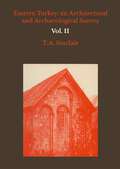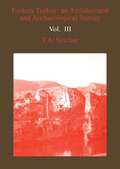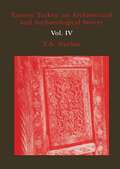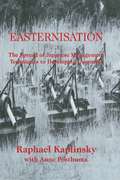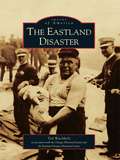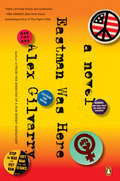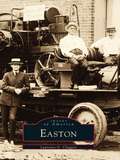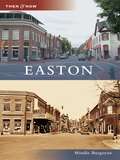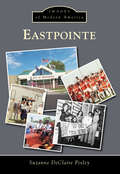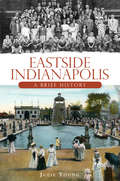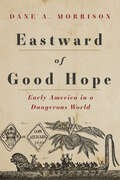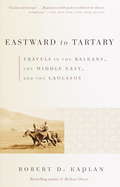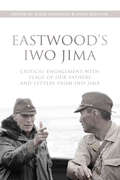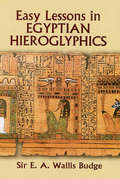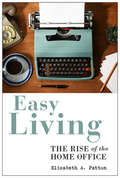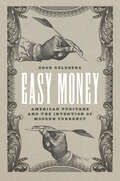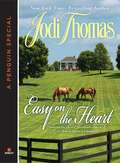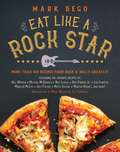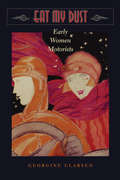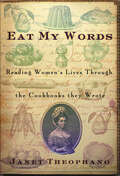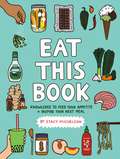- Table View
- List View
Eastern Turkey: An Architectural and Archaeological Survey, Volume II
by T A SinclairThis second volume continues with a description of the fine Georgian monuments of the Tao region, including Ihan, Ok Vank, and Haho. The Pontus region comes next, the centre of the medieval Greek empire of Trebizond. The many Byzantine churches of Trabzon itself are covered, including Aya Sofya and the nearby monasteries of Sumela and Vazelon. The many surviving churches and castles of this period and later in the Pontus are also dealt with. There follows a survey of the early Turkish architecture of Erzurum and the surrounding district. The subsequent section, on Sivas and Tokat, deals with a rich selection of Seljuk monuments; the site of ancient Comana is also covered. The region of the Anti-Taurus contains interesting Byzantine castles. There are also Early Christian remains and medieval castles. The volume concludes with a study of the early Turkish monuments of the Upper Euphrates, in Divrigi and Erzincan, and the border castles of the 9th and 10th centuries.
Eastern Turkey: An Architectural and Archaeological Survey, Volume III
by T A SinclairIn this third volume the regions covered are to the south and east of the Taurus range, beginning with the Upper and Lower Euphrates, which includes the Byzantine and Turkish buildings of Harput, Malatya and the Keban region, where there are also a number of churches and monastic sites. The following section, on the Tigris region, runs from the Taurus to the Tur 'Abdin, a historic centre of Syrian monasticism. In Diyarbakr and Mardin there are many important Christian and Islamic monuments. This was the centre of the medieval Artukid kingdom.
Eastern Turkey: An Architectural and Archaeological Survey, Volume IV
by T A SinclairThe initial section here covers the monuments of the important Hellenistic kingdom of Commagene, and includes Edessa (Urfa), the capital of a Crusader state, where there are also significant Islamic buildings. The final section, on the Hatay, focuses on the city of Antioch, with Seleucid, Roman and Byzantine remains, and the castles of the Crusader period in its vicinity. The neo-Hittite site of Karatepe and the Georgian and Syrian monasteries in the Hatay region are also dealt with. A comprehensive bibliography and index to all four volumes comes at the end.
Eastern Westerns: Film and Genre Outside and Inside Hollywood (Media, Culture and Social Change in Asia)
by Stephen TeoThe western, one of Hollywood’s great film genres, has, surprisingly, enjoyed a revival recently in Asia and in other parts of the world, whilst at the same time declining in America. Although the western is often seen as an example of American cultural dominance, this book challenges this view. It considers the western from an Asian perspective, exploring why the rise of Asian westerns has come about, and examining how its aesthetics, styles and politics have evolved as a result. It analyses specific Asian Westerns as well as Westerns made elsewhere, including in Australia, Europe, and Hollywood, to demonstrate how these employ Asian philosophical and mythical ideas and value systems. The book concludes that the western is a genre which is truly global, and not one that that is purely intrinsic to America.
Eastern and Western Ideas for African Growth: Diversity and Complementarity in Development Aid (Routledge-GRIPS Development Forum Studies)
by Kenichi Ohno Izumi OhnoThe West and the East approach economic development differently. The Europeans and Americans stress free and fair business climate, promoting private activities generally without picking winners, and improving governance. East Asia is interested in achieving concrete results and projects rather than formal correctness, prioritizing a few sectors for industrialization, and eventual graduation from aid. The West mostly shapes shifting strategies of the international donor community while the East has in reality made remarkable progress in industrial catch-up. The two approaches cannot be merged easily but they can be used in proper combination to realize growth and economic transformation. This book proposes more dialogue and complementarity between the two in the development effort of Africa and other regions. In this collected volume, contributed by experts and practitioners from both East and West, the need to introduce Eastern ideas to the global development strategy is emphasized. Analysis of British and other Western donor policies is given while Japanese, Korean, and other Asian approaches are also explained with concrete examples. The concept of governance for growth is presented and the impact of rising China on development studies is contemplated. The practices of industrial policy dialogues and actions assisted by East Asian experts are reported from Tunisia, Zambia, Ethiopia, Rwanda, and others. The book should be applicable to all donors, institutions, NGOs and business enterprises engaged in development cooperation.
Easternization: The Spread of Japanese Management Techniques to Developing Countries
by Raphael Kaplinsky Anne PosthumaJapanese industry has shown its superiority in a range of traded goods sectors. It was thought that this competitive advantage arose from the use of electronics-based flexible automation technologies, but it is now clear that the major source of this industrial strength is in the development and diffusion of new management techniques such as just-in-time production and total quality management.A number of Western firms have begun to introduce these management techniques and have begun to reap significant benefits, not just in lowering costs but also in improving product variety and quality, and in being able to satisfy customer needs more effectively. This is a practical and relevant book for those involved in the areas of policy and production, as well as being of relevance to those in the teaching and research communities.
Eastland Disaster, The (Images of America)
by Chicago Historical Society land Disaster Historical Society Ted WachholzMore than 7,000 people living in the Chicago area and Michigan City, Indiana, eagerly anticipated Saturday morning, July 24, 1915. This particular Saturday was going to be anything but a routine summer day. Plans had been carefully made for it to be the social and entertainment event of the year, and for some, a lifetime. The fifth annual midsummer excursion and picnic had been organized by the employees of the Western Electric Company's Hawthorne Works. Thousands of carefree merrymakers would enjoy a festive day including a lovely cruise across Lake Michigan to an awaiting parade and day-long picnic. The day would conclude with an evening cruise back to Chicago. For thousands of hard-working immigrant laborers and their families and friends, it was going to be a day to remember. Instead, the day's scheduled event turned into a tragedy unlike any other. The SS Eastland, while still tied to the wharf, rolled into the Chicago River with more than 2,500 passengers on board. Nearly 850 people lost their lives, including 22 entire families. The ensuing struggle for survival, and the resulting death, heroism, cowardice, greed, and scandal gripped the city of Chicago.
Eastman Was Here
by Alex Gilvarry"Absorbing...Eastman is a riveting…presence who demands to be loved and remembered." –The Boston GlobeAn ambitious new novel set in the literary world of 1970s New York, following a washed-up writer in an errant quest to pick up the pieces of his life. One of The Millions’ Most Anticipated Books of the Second Half of 2017 and BuzzFeed's Exciting New Books You Need To Read This Summer The year is 1973, and Alan Eastman, a public intellectual, accidental cultural critic, washed-up war journalist, husband, and philanderer; finds himself alone on the floor of his study in an existential crisis. His wife has taken their kids and left him to live with her mother in New Jersey, and his best work feels as though it is years behind him. In the depths of despair, he receives an unexpected and unwelcome phone call from his old rival dating back to his days on the Harvard literary journal, offering him the chance to go to Vietnam to write the definitive account of the end of America's longest war. Seeing his opportunity to regain his wife’s love and admiration while reclaiming his former literary glory, he sets out for Vietnam. But instead of the return to form as a pioneering war correspondent that he had hoped for, he finds himself in Saigon, grappling with the same problems he thought he'd left back in New York. Following his widely acclaimed debut, From the Memoirs of a Non-Enemy Combatant, Alex Gilvarry employs the same thoughtful, yet dark sense of humor in Eastman Was Here to capture one irredeemable man's search for meaning in the face of advancing age, fading love, and a rapidly-changing world."With his second book, Gilvarry establishes himself as a writer who defies expectation, convention and categorization. Eastman Was Here is a dark, riotously funny and audacious exploration of the sacred and the profane—and pretty much everything in between." —Téa Obreht, New York Times bestselling author of The Tiger's Wife
Easton (Images of America)
by Laurence G. ClaggettIn the early part of the 18th century, Talbot County on Maryland's Eastern Shore was restructured in size and boundary, requiring the designation of a new county seat. Groups from the Wye River to Oxford competed vigorously to have their town win the honor. But the selection committee, with manifestpartiality, decided upon the geographical center of the new county: a remote field cultivated and thenabandoned by its native residents. Here was born thetown that would eventually be known as Easton. Telling the story of the original Talbot CourtHouse, the market, early schools, churches, andbusinesses, this fascinating visual history documentsan era of significant change for the town in the early 20th century. Improved roads and transportationallowed the widespread population of the county to come to town; friends and family members could meetmore often, and a sense of community identity began to grow.
Easton (Then and Now)
by Mindie BurgoyneNamed Easton in 1788, the principal town on Maryland's Eastern Shore grew to be its center of government and commerce. These images chart Easton's transformation into Maryland's eastern hub for the arts, culture, and entertainment, revealing the town's treasure trove of Victorian and Colonial buildings, historic streetscapes, and the oldest Quaker meetinghouse in the United States.
Eastpointe (Images of Modern America)
by Suzanne Declaire PixleyLocated in southeast Michigan, Eastpointe is typical of many suburban cities of middle America. During its development phase, Eastpointe's businesses and residents became involved in work or services related to the automotive industry. Structural changes occurred at a rapid rate as population density and diversity, technology, and economic changes impacted the community in rapid succession. When the automotive industry slowed, the income to Eastpointe residents, schools, and the city also slowed, yet the resiliency of the community allowed the city to survive.
Eastside Indianapolis: A Brief History (Brief History)
by Julie YoungIn its early days, Indianapolis was designed to be a city of only one square mile, but as settlers flocked to the Circle City, a steady beat of progress made its way across the Eastside. Through their dedication to maintaining the character of neighborhoods like Woodruff Place, Fountain Square and Irvington, Eastsiders have banded together time and again to preserve the memories of landmarks like the Rivoli Theatre and Al Green's. Julie Young, a lifelong resident of the Eastside, celebrates one of the most culturally diverse areas of Indianapolis as she illuminates the strength and determination that would make any resident proud to call the Eastside home.
Eastward of Good Hope: Early America in a Dangerous World
by Dane A. MorrisonHow did news from the East—carried in ship logs and mariners' reports, journals, and correspondence—shape early Americans' understanding of the world as a map of dangerous and incoherent sites?Freed from restrictions of British mercantilism in the years following the War of Independence, Yankee merchants embarked on numerous voyages of commerce and discovery into distant seas. Through the news from the East, carried in mariners' reports, ship logs, journals, and correspondence, Americans at home imagined the world as a map of dangerous and deranged places. This was a world that was profoundly disordered, hobbled by tyranny and oppression or steeped in chaos and anarchy, often deadly, always uncertain, unpredictable, and unstable, yet amenable to American influence. Focusing on four representative arenas—the Ottoman Empire, China, India, and the Great South Sea (collectively, the East Indies, Oceana, and the American continent's Northwest coast)—Eastward of Good Hope recasts the relationship between America and the world by examining the early years of the republic, when its national character was particularly pliable and its foundational posture in the world was forming. Drawing on recent scholarship in global ethnohistory, Dane A. Morrison recounts how reports of cannibal encounters, shipboard massacres, shipwrecks, tropical fever, and other tragedies in distant seas led Americans to imagine each region as a distinct set of threats to their republic. He also demonstrates how the concept of justification through self-doubt allowed for aggressive expansionism and for the foundations of imperialism to develop.Morrison reconsiders American ideas about the world through three questions: How did British Americans imagine the world before independence allowed them to travel "Eastward of Good Hope"? What were the signal encounters that filled the public sphere in their early years of global encounter? And finally, how did Americans' contacts with other peoples inflect their ideas about the world and their place in it? Written in a lively, engaging style, Eastward of Good Hope will appeal to scholars and the general public alike.
Eastward to Tartary
by Robert D. KaplanEastward to Tartary, Robert Kaplan's first book to focus on a single region since his bestselling Balkan Ghosts, introduces readers to an explosive and little-known part of the world destined to become a tinderbox of the future.Kaplan takes us on a spellbinding journey into the heart of a volatile region, stretching from Hungary and Romania to the far shores of the oil-rich Caspian Sea. Through dramatic stories of unforgettable characters, Kaplan illuminates the tragic history of this unstable area that he describes as the new fault line between East and West. He ventures from Turkey, Syria, and Israel to the turbulent countries of the Caucasus, from the newly rich city of Baku to the deserts of Turkmenistan and the killing fields of Armenia. The result is must reading for anyone concerned about the state of our world in the decades to come.
Eastwood's Iwo Jima: Critical Engagements with Flags of Our Fathers and Letters from Iwo Jima
by Rikke Schubart Eds. Gjelsvik AnneWith Flags of Our Fathers (2006) and Letters from Iwo Jima (2006), Clint Eastwood made a unique contribution to film history, being the first director to make two films about the same event. Eastwood's films examine the battle over Iwo Jima from two nations' perspectives, in two languages, and embody a passionate view on conflict, enemies, and heroes. Together these works tell the story behind one of history's most famous photographs, Leo Rosenthal's "Raising the Flag on Iwo Jima." In this volume, international scholars in political science and film, literary, and cultural studies undertake multifaceted investigations into how Eastwood's diptych reflects war today. Fifteen essays explore the intersection among war films, American history, and Japanese patriotism. They present global attitudes toward war memories, icons, and heroism while offering new perspectives on cinema, photography, journalism, ethics, propaganda, war strategy, leadership, and the war on terror.
Easy Lessons in Egyptian Hieroglyphics
by E. A. BudgeWritten by perhaps the most prolific, erudite Egyptologist of the 20th century, this solid guide to hieroglyphics remains the standard introduction. Budge gives the history of hieroglyphic writing, its evolution into hieratic and demotic scripts, and the fascinating tale of its decipherment by Young, Champollion, Åkerblad, and others.
Easy Living: The Rise of the Home Office
by Elizabeth A PattonHow did Americans come to believe that working at home is feasible, productive, and desirable? Easy Living examines how the idea of working within the home was constructed and disseminated in popular culture and mass media during the twentieth century. Through the analysis of national magazines and newspapers, television and film, and marketing and advertising materials from the housing, telecommunications, and office technology industries, Easy Living traces changing concepts about what it meant to work in the home. These ideas reflected larger social, political-economic, and technological trends of the times. Elizabeth A. Patton reveals that the notion of the home as a space that exists solely in the private sphere is a myth, as the social meaning of the home and its market value in relation to the public sphere are intricately linked.
Easy Money: American Puritans and the Invention of Modern Currency (Markets and Governments in Economic History)
by Dror GoldbergA sweeping history of the American invention of modern money. Economists endlessly debate the nature of legal tender monetary systems—coins and bills issued by a government or other authority. Yet the origins of these currencies have received little attention. Dror Goldberg tells the story of modern money in North America through the Massachusetts colony during the seventeenth century. As the young settlement transitioned to self-governance and its economy grew, the need to formalize a smooth exchange emerged. Printing local money followed. Easy Money illustrates how colonists invented contemporary currency by shifting its foundation from intrinsically valuable goods—such as silver—to the taxation of the state. Goldberg traces how this structure grew into a worldwide system in which, monetarily, we are all Massachusetts. Weaving economics, law, and American history, Easy Money is a new touchstone in the story of monetary systems.
Easy Target
by Tom SmithTom Smith didn't seem like the perfect candidate to fight for the United States in the Vietnam conflict, but being recruited for active duty gave him more than he bargained for. Chosen as an aero scout leading an elite squadron on combat missions, his job was to attract Viet Cong fire in order that the enemy be located and destroyed--a job with a fifty percent survival rate. From flying battle runs to rescuing wounded infantry to pulling off daring last-minute escapes, this is the incredible and unforgettable true first-hand account of the unlikeliest hero ever to survive a war.
Easy on the Heart (Novella)
by Jodi ThomasThere's nothing like a cowboy to stir a lady's imagination--and nobody can do it better than New York Times bestselling author Jodi Thomas. AVAILABLE DIGITALLY FOR THE FIRST TIME It's Cooper Adams's thirtieth birthday and his three older sisters have arrived at his Dallas ranch stanchly determined to find their rough-hewn cowboy brother a wife. Cooper isn't necessarily opposed to marriage, he just figures he's old enough to make his own decisions. There's just one problem. He doesn't know much about the ways of women, seeming a heck of lot more complicated than tending to a ranch. Then one day at the general store, his spots Mary Woodburn. At first sight, she's the nicest gift he could have received. She's shy and gentle, sweetly receptive, and darn near irresistible. But she's also a damn Yankee, the kind of woman Cooper never dreamed he'd find himself falling for. Now he can't stop thinking about her. And differences aside, with proper tending, theirs could be a love story as big as Texas itself. Includes a preview of Jodi Thomas's latest Whispering Mountain novel, Promise Me Texas Easy on the Heart previously appeared in How to Lasso a Cowboy
Eat Him If You Like
by Jean TeuléThe Perigord: a beautiful August day. Kind, well-respected young nobleman, Alain de Monèys, sets off happily for the local fair at Hautefaye.But this is the summer of 1870, a time of terrible drought and even worse defeats for France in the Franco-Prussian war. One misheard comment at the fair sets in motion an horrific train of events that Alain, for all his popularity, is powerless to stop...Based on a shamefully brutal incident from French history, Jean Teulé's riveting story shows how easily a group of individuals can turn into an irrational, bloodthirsty mob.
Eat Like a Rock Star: More Than 100 Recipes from Rock 'n' Roll's Greatest
by Mark Bego Mary WilsonWho knew that Bill Wyman (The Rolling Stones) makes an amazing Lamb Chops with Endive and Blue Cheese Salad, that Michael McDonald (The Doobie Brothers) loves Pasta with Ham and Parmesan Cheese, or that Boz Scaggs eats Tuscan Grilled Chicken?With more than a hundred recipes from seven decades of rock ‘n’ roll, pop, country, RnB, and disco, Mark Bego, along with Mary Wilson of The Supremes, gathers beloved recipes from legendary rocker friends and invites the ultimate music fan to put on an apron and join them at the table. Featuring each rock star’s biography, their favorite recipe, and other fun facts, Eat Like a Rock Star is a must-have for every die-hard rocker-at-heart who loves to eat.There is nowhere else you will find Ray Parker Jr.’s Salmon and Eggs, Joey Fatone’s (NSYNC) Rice Balls, Micky Dolenz’s (The Monkees) Micky ‘D’ Cocktail, and Angela Bowie’s (David Bowie’s ex-wife’s) Rosti Hash Brown Potatoes all in one book. Whether it’s brunch, lunch, dinner, or desert, learn to cook:•Michelle Phillips’s (The Mamas & The Papas) Organic Lemon Chicken•Lou Christie’s Linguine with Fresh Tomatoes•Marilyn McCoo's (The 5th Dimension) Leg of Lamb•Glen Campbell’s Favorite Mexican Chicken Casserole•Sarah Dash’s (Patti LaBelle and the Bluebelles) Peach Cobbler, and more!With a section on head-spinning cocktails, full menu suggestions, as well as author Mark Bego’s own culinary concoctions such as Spicy Szechuan Sesame Noodles and Boozy Banana Cream Pie, look no further for the all-in-one cooking and rock ‘n’ roll companion. As Martha Reeves says about her Smoked Turkey Necks & Lima Beans, “Honey, this is real soul food!”
Eat My Dust: Early Women Motorists (The Johns Hopkins University Studies in Historical and Political Science #126)
by Georgine ClarsenThe history of the automobile would be incomplete without considering the influence of the car on the lives and careers of women in the earliest decades of the twentieth century. Illuminating the relationship between women and cars with case studies from across the globe, Eat My Dust challenges the received wisdom that men embraced automobile technology more naturally than did women.Georgine Clarsen highlights the personal stories of women from the United States, Britain, Australia, and colonial Africa from the early days of motoring until 1930. She notes the different ways in which these women embraced automobile technology in their national and cultural context. As mechanics and taxi drivers—like Australian Alice Anderson and Brit Sheila O'Neil—and long-distance adventurers and political activists—like South Africans Margaret Belcher and Ellen Budgell and American suffragist Sara Bard Field—women sought to define the technology in their own terms and according to their own needs. They challenged traditional notions of femininity through their love of cars and proved they were articulate, confident, and mechanically savvy motorists in their own right.More than new chapters in automobile history, these stories locate women motorists within twentieth-century debates about class, gender, sexuality, race, and nation.
Eat My Words: Reading Women's Lives Through the Cookbooks they Wrote
by Janet TheophanoSome people think that a cookbook is just a collection of recipes for dishes that feed the body. In Eat My Words: Reading Women's Lives through the Cookbooks They Wrote, Janet Theophano shows that cookbooks provide food for the mind and the soul as well. Looking beyond the ingredients and instructions, she shows how women have used cookbooks to assert their individuality, develop their minds, and structure their lives. Beginning in the seventeenth century and moving up through the present day, Theophano reads between the lines of recipes for dandelion wine, "Queen of Puddings," and half-pound cake to capture the stories and voices of these remarkable women.The selection of books looked at is enticing and wide-ranging. Theophano begins with seventeenth-century English estate housekeeping books that served as both cookbooks and reading primers so that women could educate themselves during long hours in the kitchen. She looks at A Date with a Dish, a classic African American cookbook that reveals the roots of many traditional American dishes, and she brings to life a 1950s cookbook written specifically for Americans by a Chinese émigré and transcribed into English by her daughter. Finally, Theophano looks at the contemporary cookbooks of Lynne Rosetto Kaspar, Madeleine Kamman, and Alice Waters to illustrate the sophistication and political activism present in modern cookbook writing. Janet Theophano harvests the rich history of cookbook writing to show how much more can be learned from a recipe than how to make a casserole, roast a chicken, or bake a cake. We discover that women's writings about food reveal--and revel in--the details of their lives, families, and the cultures they help to shape.
Eat This Book: Knowledge to Feed Your Appetite and Inspire Your Next Meal
by Stacy MichelsonExplore 99 of the world&’s most beloved, delicious, and misunderstood foods in this charming culinary compendium from artist extraordinaire Stacy Michelson.Eat This Book is part celebration, part education, packed with bite-size nuggets of knowledge about unique farmers&’ market finds, kitchen pantry staples, and fascinating global ingredients. You&’ll gain a new appreciation for seemingly familiar foods, and learn the backstory of some that have always seemed a bit more mysterious. Whether you&’re a novice cook or completely food obsessed, there&’s plenty here to feed your curiosity.
